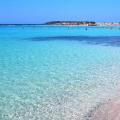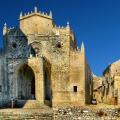
Haakons Hall (Hall of Haakon) is almost 750 years old: this castle was created by King Haakon Haakonsson as a private residence with a special imposing banquet hall.
Historical reference about Hawcons Hall
Construction was carried out in the period 1247-1261. When King's son Magnus Håkonsson Lagabot married Princess Ingeborg of Denmark in 1261, 2,000 guests were invited to the feast. The king held the court in a stone hall, says the ancient saga. In that era, Bergen was the most important and largest city the country, and the Haakon Hall was the venue for major national events.
When Norway united with the other Scandinavian countries, the castle's importance declined. They even set up a grain storage here. It was decided to restore the former glory of the hall only in the second half of the 19th century. During World War II, the castle suffered a lot, and the romantic inscriptions on the walls and vaults were lost forever.
But even today, behind thick walls of stone, echoes of ceremonies from the Middle Ages, as well as ritual celebrations, go. As a national monument, the Haakon Hall is sometimes used for official ceremonies to this day. His Majesty himself also visits him.
The hall is open during the World Festival in Bergen, at Easter, Christmas, as well as on special occasions and on public holidays. The cafe is open here in the summer from June to August.
Rosencrantz Tower
Not far from Haakons Hall in Bergenhus is the Rosencrantz Tower. This is a fortress structure of a later time. It was erected in 1560 by order of Rosenkrantz, who was the governor of Bergenhus. He wanted to strengthen his own housing with a defensive structure. These were built on the site of older ones, because some parts are dated 1270. The tower was altered and enlarged over time. Guns were installed on its roof. Today, this building is quite rough in appearance, which is considered one of the most important monuments of the Renaissance.
To the top of the tower, you can climb a dark and cramped staircase that leads directly to the roof. At that time, the city was just a part of the Hansa; it received a special status because of the office created in it. The Bergen merchants were rapidly gaining weight. The essence of the tower was also in the demonstration of strength that can withstand the might of the Hanseatic League.
The wide facade faces Bryggen, then it was a trade and business center, there are also gun slots turned there. During World War II, during the explosion of the Bergen harbor, some of the tower was destroyed, and its restoration took more than 20 years. The tower has been part of the Bergen Museum since 1966.
To date, two have survived on its territory. historic buildings: Hall of Haakon, created for King Håkon IV Håkonsson in the 13th century and Rosenkrantztårnet Tower, built later, three centuries later. Nowadays, museums are located in both buildings. The entrance to the territory of the fortress is free, and the entrance to each of the museums is 80 kroons, for students - 40 kroons (2017).
During a walk through the fortress, you will be first greeted by the Rosencrantz tower with a blue dome crowning it. The appearance of the building will remind you a little chess piece queen.
The first fortification on the site of the tower appeared in the 1270s, when Bergen was the capital of Norway. It was built during the reign of King Magnus Lagaböter. Three centuries later, in the 1560s, the building was rebuilt as the governor's residence. The commandant at that time was a Danish citizen Eric Rosencrantz, whose name the building bears to this day.
Both residential, richly decorated rooms and premises with a purely military purpose were created in the building. So, the top floor was set aside for artillery. On the powerful facade there are loopholes directed towards the Hanseatic embankment, built up with merchant houses. Thus, the power of feudal power and the need to subordinate the merchants of Bergen to it were shown.
Entering the inside of the fortification, you will see how the medieval castle was arranged, walk along its narrow corridors, halls and staircases. In the morning there are few people here and you can get lost, but on the other hand, you will fully experience the mysterious atmosphere of the old building.
The Rosencrantz Tower is one of the symbols of Bergen. And although this structure looks rather rough, nevertheless, it is considered one of the most important monuments of the Norwegian Renaissance. We see that the features of the Renaissance style gradually penetrate into Norway, but its elements are not expressed clearly and do not prevail.
One of the stairs will lead you to observation deck located on the roof. The Rosencrantz Tower is below many of the buildings in Bergen and the view from it will be limited to the bay and the Bryggen quarter, ships are also visible at the cruise port.
Like many structures in Bergen, the building was damaged in an explosion in the bay of an ammunition ship in 1944. Thanks to the preserved drawings, it was recreated in its original form and a museum has been opened here since 1966.
In one of the halls there are copies of knightly armor that can be worn and photographed. And the most interesting hall is located on the top floor, its expositions tell about one of the episodes of the Second Anglo-Dutch War of 1665, in the center of which was Bergen.
In June 1665, the First Battle of Lowestough took place, in which England defeated the Dutch fleet and began to control the English Channel and the trade routes of the North Sea.
At this time, a caravan of merchant ships with a cargo of 11 million guilders was heading from the East Indies to Holland. Bergen was part of Denmark at the time. Denmark was an ally of Holland. Therefore, the captain of the Dutch cargo convoy, Michael de Ruyter, sent merchant ships to Bergen to await the arrival of the Dutch warships there and accompany them to Holland.
Frederick III, King of Denmark and Norway, pondered for a long time what to do. On the one hand, he believed that Holland did not help him enough in defense, and the cargo literally sailed to the port itself. He wanted to confiscate it and negotiate with England. But on the other hand, he did not dare to quarrel completely with the Netherlands. In addition, he could take payment for saving the cargo.
After much hesitation, he decided to take the side of England. While in Copenhagen, the king sent a messenger to inform the commander of the Danish armed forces in Norway, General Klaus von Alefeldt, of his decision. At the same time, the British, fearing that reinforcements from Holland would come to protect the cargo, were the first to attack and began to shoot at the Dutch ships. But due to fog, wind and smoke, they accidentally got into the fortress. As a result, two Norwegians died. The messenger by this time did not reach the fortress, and the commander thought that the British had attacked them and ordered them to side with the Dutch, although the royal order was the opposite.
This is the interest of history. V modern world where there are telephones and cellular communications, this is impossible. In fact, the Dutch won the battle because the messenger had been traveling for too long. As compensation for assistance in protection from the attack of the British, the Norwegians confiscated the Dutch guns and part of their goods.
Opening hours in 2019
- During the summer period from 15 May to 15 September daily from 10:00 to 16:00
- From January 2 to May 14, Saturdays and Sundays from 12:00 to 15:00
- From September 16 to December 20 on Sundays from 12:00 to 15:00
- Closed: April 20 and 21, May 1 and 17, December 21 - January 1
Ticket prices in 2019
- Adults - 100 CZK
- For students - 50 CZK
- For children under 16 years old - free
There is reason to believe that the first fortress of Bergen was built in the 11th century. on the isle of Holmen, which is connected to the city by two isthmuses. On the territory of this fortress in 1066-1093. erected Cathedral, in which the first kings were crowned and married.
In the XIII century. the country, the capital of which was then Bergen, was ruled by Haakon IV Haakonson. On the site of the Holmen fortress, he ordered the construction of a royal castle. The construction of the palace lasted from 1247 to 1261. In the new castle, weddings were held, and then the coronation of Magnus VI Haakonson Lagaböter, son of Haakon IV.
The palace is 37 m long and 16 m wide. It is the largest secular building built in Norway during the Middle Ages. Initially, it had three floors: the first was used for storing provisions, the second for living, and the third for ceremonies.
In 1299 the capital of Norway moved to, and the castle in Bergen was used as a defensive structure. After the country lost its independence in the XIV century. the palace began to decline and even served as a barn.
On April 20, 1944, a German ship with ammunition exploded in the harbor. Many buildings in Bergen were damaged, and only damaged walls remained from the castle. For the reconstruction, carried out in 1955-1961, old engravings and photographs were used, which made it possible to restore the original appearance of the Haakon Palace. Today there is a museum exposition, concerts and official events are held here.
Rosencrantz Tower
The Rosencrantz Tower is considered the symbol of Bergen and one of its main attractions. The first tower on this site appeared during the reign of King Magnus VI Haakonson Lagaböter in the 1270s. Her images have not survived.
In the 1560s. Erik Rosencrantz held the post of commandant of the tower. It was at this time that the Scottish stonemasons carried out a major reconstruction of the building. The tower, which since then bears the name of Rosencrantz, was to become a fortified governor's residence. The living quarters used rich finishes. To protect the tower, artillery was placed on its top floor.
The wide façade of the Rosencrantz tower opened onto a separated strait that existed according to the rules of the Hanseatic League. Feudal lords dreamed of dominating free traders and demonstrated their power to them.
The Rosencrantz Tower, like other buildings in Bergen, was damaged by an explosion of a ship with ammunition in April 1944. Its restoration was completed in 1966, after which a museum was opened in the building.
Previous photo Next photo



Haakons Hall (Haakon Hall) is almost 750 years old: this castle was built by King Haakon Haakonsson as his own residence with an especially impressive banquet hall. Construction lasted from 1247 to 1261. When the royal son, Magnus Håkonsson Lagabot, celebrated a wedding with the Danish princess Ingeborga in 1261, two thousand guests were invited to the feast. “The king was judging in a stone hall,” says the words of the ancient saga. At this time, Bergen was the largest and most important city in the entire country, and the Haakon Hall was the venue for major events of a national scale; in particular, the promulgation of the first complete Norwegian Code of Laws.
The echoes of medieval ceremonies and ritual festivals still roam behind the thick stone walls.
When Norway united with the rest of Scandinavia, the castle's importance declined. A granary was even equipped here. It was decided to restore the former glory of the hall only in the second half of the 19th century. During the Second World War, the castle suffered a lot, and the romantic paintings of the walls and vaults were lost forever. But even now, behind the thick stone walls, the echo of medieval ceremonies and ritual festivals wanders. As a national monument, Haakons Hall is still sometimes used for official ceremonies. He is visited, in particular, by His Majesty himself.
The Haakon Hall is closed during the Bergen International Festival, Christmas, Easter and special occasions, and on public holidays May 1 and 17. The café on site is open summer season: from June to August.
Near Haakons Hall on the territory of the Bergenhus Fortress is the Rosencrantz Tower, a fortification over late period... It was built in 1560 by order of Rosencrantz, the governor of Bergenhus, who wished to strengthen his own home with defensive structures. Those were erected on the site of the older ones, built under the very same Magnus, so some parts of the tower date back to 1270. The tower was rebuilt and expanded over time; and guns were mounted on its roof. Today it is a rather rough-looking building, which is nevertheless considered one of the most important monuments of the Norwegian Renaissance.
You can climb to the top of the Rosencrantz tower by a narrow and dark staircase that leads directly to the roof.
At that time, the city just became part of the Hansa and received a special status thanks to the office opened in it. The merchants of Bergen were rapidly gaining weight. The meaning of the tower was, among other things, in a demonstration of strength capable of withstanding the power of the independent Hanseatic League. The wide façade of the tower looks directly at Bryggen, the then business and shopping center, and there the gun slots are threateningly directed.
During World War II, an explosion in Bergen harbor destroyed part of the tower, and its restoration took over the next 20 years. Since 1966, it has become part of the Bergen Museum.
Around the Haakon Hall and Rosencrantz Tower, on the territory of Bergenhus, you can pleasantly walk in a pretty park or climb up to Sverreborg, an old defensive structure. From there you can see the surrounding hills and the pretty city roofs block.





